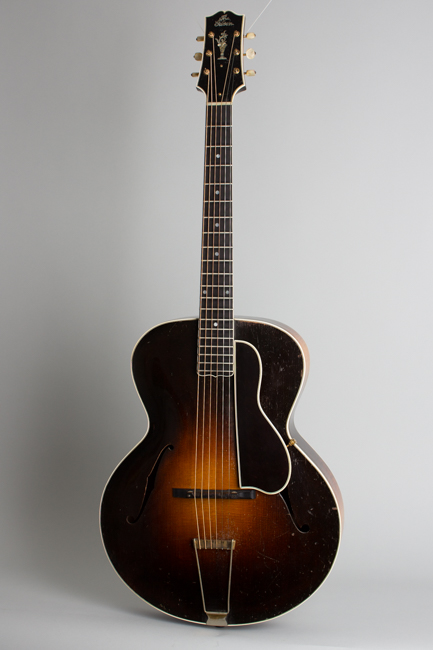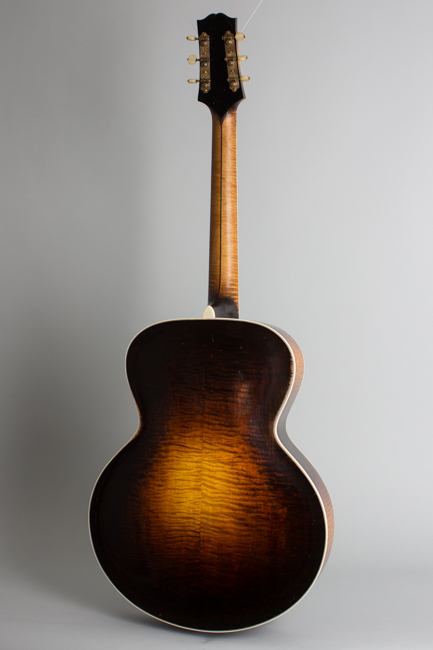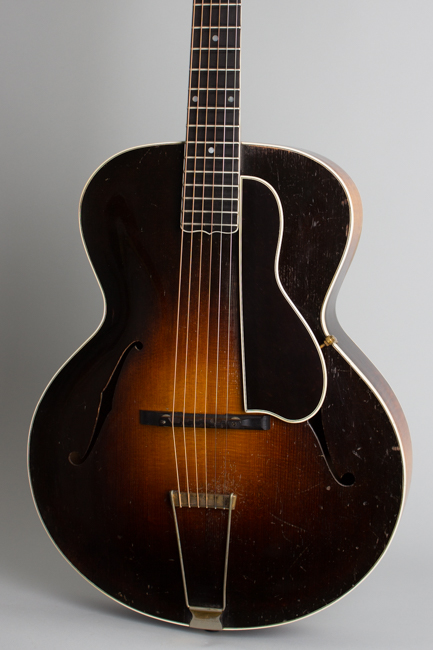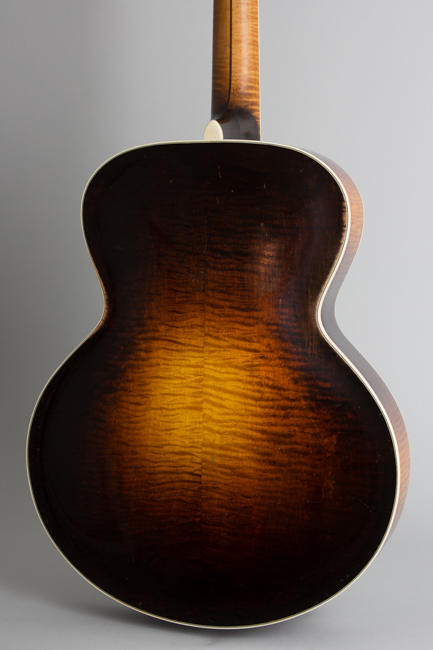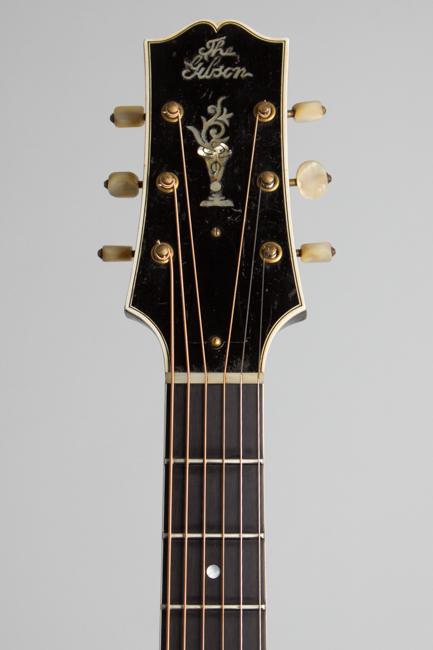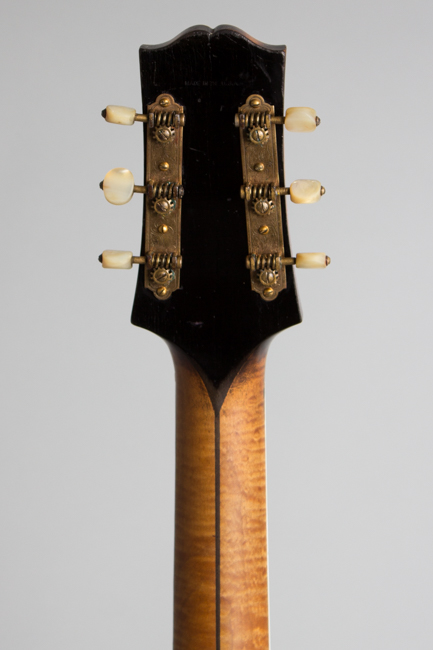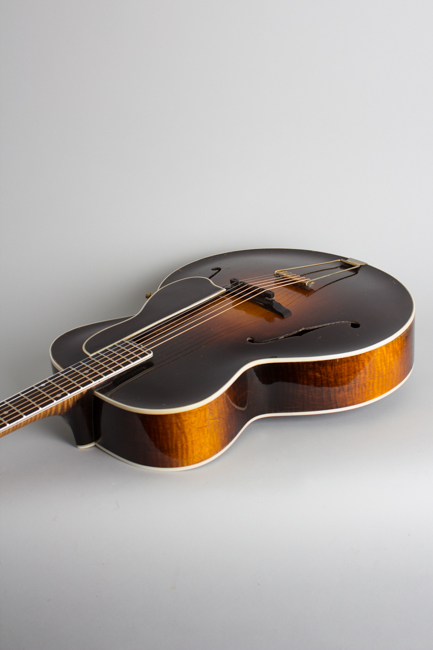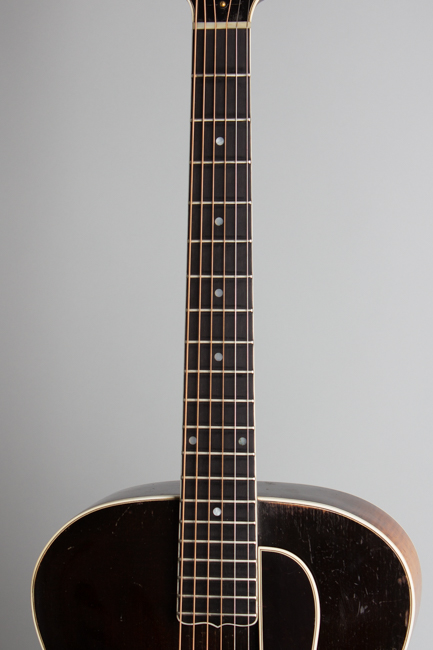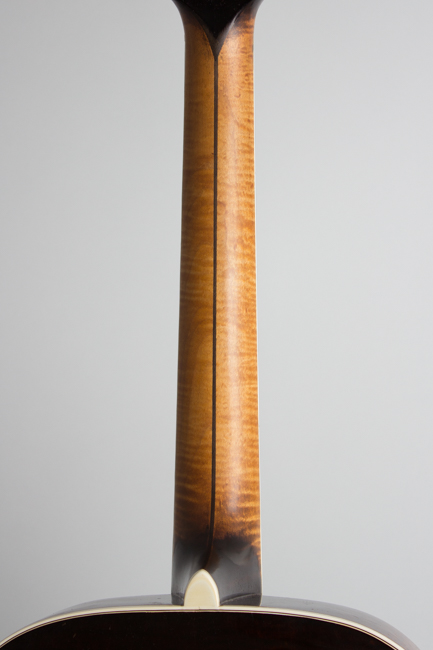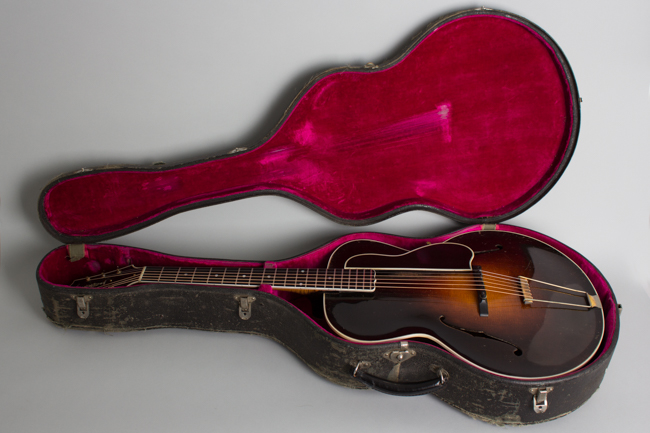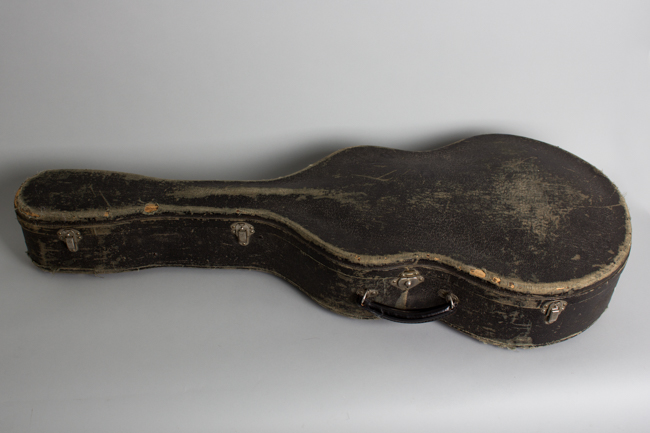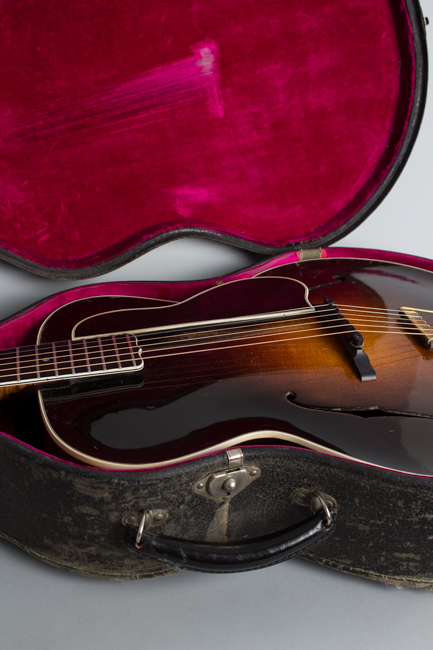Gibson L-5 Arch Top Acoustic Guitar (1931)
This item has been sold.
Item # 10000
Prices subject to change without notice.
Gibson L-5 Model Arch Top Acoustic Guitar (1931), made in Kalamazoo, Michigan, serial # 87060, Cremona Brown Sunburst finish, maple back and sides, spruce top; laminated maple neck with ebony fingerboard, original black hard shell case.
This 1931 L-5 is a beautiful example of the pre-eminent professional guitar of its era -- the original f-hole archtop guitar -- and an extremely fine-sounding instrument by any standard. Debuting in 1923-4, the L-5 was the first modern archtop, combing the violin style f-holes, a 14th fret neck joint and the elevated fingerboard for the first time. At the time this one in was built in early/mid 1931 it was the top of Gibson's line and had no serious competition yet, universally considered the finest orchestra guitar made. Other makers were just beginning to explore this avenue, and the L-5 was the inspiration for all and a template for most other f-hole guitars that followed including an entire line of Epiphones launched this same year.
Orchestra and jazz band banjoists were by this time almost universally converting to guitar; the $275.00 L-5 along with Epiphone's competing Deluxe -- which debuted in mid-1931 -- became the choice of nearly all top professional guitar players. Eddie Lang, the era's most influential guitarist, went from a Gibson L-4 to a dot-neck (probably 1927-8) L-5, then to an early block neck L-5 around 1931 setting the trend for all to follow. In mid-1931, when this one was shipped, the L-5 ruled the roost for orchestra guitars giving Gibson a market dominance that they never lost.
That said, these 1920s and early 1930s L-5s are fairly rare guitars today. Retailing at $275.00 (plus case!), the L-5 was extremely expensive (a top-of-the-line Martin pearl-trimmed Style 0M-45 retailed exactly $100.00 less). In 1931-2 at the height of the Depression only top professional users with steady salaries could afford the indulgence of such an instrument.
This guitar shows typical features for a 1927-31 L-5; the transition between variants is inexact and the serial numbers are not in strict order with the progression of features. This example carries the original pearl dot inlayed, triple white-black-white edge bound, 20 fret fingerboard ending in a curled point and the original mother of pearl nut. The 3-piece laminated curly maple neck has a comfortable and rather shallow "V" profile, quite unlike the much deeper necks of a year or so earlier. The frets are modern replacements, slightly larger than the original specification, recently dressed for optimum playability.
The pearl inlaid flowerpot in the triple-bound headstock and straight across "The Gibson" logo are the hallmarks of the 1931 L-5, as are the original engraved, gold plated and mother-of-pearl buttoned Waverly tuners. The back of the headstock features an ebony overlay, a feature of the earliest L-5's. It is stamped with very small letters "Made in the U.S.A.", a marking seen only on instruments that Gibson originally sold for export outside the US.
The body on this particular guitar is, like many early L-5s, just a hair over 16 inches wide, triple-bound back and front. The spruce top and fantastic flame maple back and sides carry a beautifully blended dark Cremona Brown sunburst finish. The oft-missing original short triple-bound celluloid pickguard (stamped "Pat.MAR.30.09") is still with the guitar. The tailpiece has the older "string over" cross bar stamped "Patented July 19, 1910." The bridge is ebony, stamped "PAT'D JAN 18-21." The tailpiece and bridge base are original to the guitar, while the ebony bridge top is a modern reproduction.
The braces on this instrument are the original solid carved design, not the "kerfed" bracing (partially cut through to make it quicker and easier to fit) that began to appear on L-5s around this time. This is generally held to be a sonic plus -- certainly this guitar has a powerful and very versatile sound typical of the best early L-5s; simultaneously warm and incisive with plenty of depth. It plays extremely well and is exceptionally responsive for an archtop guitar...it even sounds lovely fingerstyle! This is a well-played but wonderful example of one of our all-time favorite instruments, both historically important and a true delight to play.
Most early 16" L-5s were used extensively for many years, some owners continuing to prefer them to any later guitars. They are still often seen in the hands of recording studio players well into the 1960s. As working guitars, these instruments have often been heavily modified, refitted, or refinished. This one is has a some general wear but both structurally and cosmetically is far better preserved than most retaining all of its original character.
Overall length is 40 1/2 in. (102.9 cm.), 16 1/16 in. (40.8 cm.) wide at lower bout, and 3 3/8 in. (8.6 cm.) in depth, measured at side of rim. Scale length is 24 3/4 in. (629 mm.). Width of nut is 1 11/16 in. (43 mm.).
This L-5 shows a decent amount of cosmetic wear overall, but overall remains both cleaner and more original than many. It is structurally very well-preserved and in excellent playing condition. The original thin lacquer finish shows some general wear throughout. There is some light overfinish and a somewhat polished out area on the bass side top, in the area where a player's arm would rest and extending through the waist. Some finish is worn through on the lower side as well, from contact with the player's knee.
The finish overall shows scratches, dings and rubbed away spots in numerous areas particularly the back (with some buckle rash and edge wear on the upper quarter) and under the crossbar of the tailpiece, dinged from decades of errant string ends. The only large area worn away is the back of the neck, which is down to the original clear undercoat for much of its length. That said the instrument is still very attractive with a subtle patina not unlike the old violins it was meant to evoke.
The guitar shows only some inconspicuous repair work, unlike many L-5's of this vintage. There are two neatly repaired top cracks; one under the bass side of the tailpiece and another under the small area of overspray at the waist on the bass side. As noted the bridge top only is a reproduction; all other hardware remains original. As noted it has been refretted, possibly more than once and the current wire has virtually no wear.
While bearing some scars from a long active life this L-5 remains an exceptional player's tool with another century of music in it, at least. It plays beautifully and the sound is truly sublime, one of the most delightful arch top guitars it has been our pleasure to handle. The original case is still with it, somewhat worn but fully functional. Until recently this L-5 was the property of noted western swing stylist Whit Smith, who used it for some years for both recording and live work. Overall Excellent - Condition.
This 1931 L-5 is a beautiful example of the pre-eminent professional guitar of its era -- the original f-hole archtop guitar -- and an extremely fine-sounding instrument by any standard. Debuting in 1923-4, the L-5 was the first modern archtop, combing the violin style f-holes, a 14th fret neck joint and the elevated fingerboard for the first time. At the time this one in was built in early/mid 1931 it was the top of Gibson's line and had no serious competition yet, universally considered the finest orchestra guitar made. Other makers were just beginning to explore this avenue, and the L-5 was the inspiration for all and a template for most other f-hole guitars that followed including an entire line of Epiphones launched this same year.
Orchestra and jazz band banjoists were by this time almost universally converting to guitar; the $275.00 L-5 along with Epiphone's competing Deluxe -- which debuted in mid-1931 -- became the choice of nearly all top professional guitar players. Eddie Lang, the era's most influential guitarist, went from a Gibson L-4 to a dot-neck (probably 1927-8) L-5, then to an early block neck L-5 around 1931 setting the trend for all to follow. In mid-1931, when this one was shipped, the L-5 ruled the roost for orchestra guitars giving Gibson a market dominance that they never lost.
That said, these 1920s and early 1930s L-5s are fairly rare guitars today. Retailing at $275.00 (plus case!), the L-5 was extremely expensive (a top-of-the-line Martin pearl-trimmed Style 0M-45 retailed exactly $100.00 less). In 1931-2 at the height of the Depression only top professional users with steady salaries could afford the indulgence of such an instrument.
This guitar shows typical features for a 1927-31 L-5; the transition between variants is inexact and the serial numbers are not in strict order with the progression of features. This example carries the original pearl dot inlayed, triple white-black-white edge bound, 20 fret fingerboard ending in a curled point and the original mother of pearl nut. The 3-piece laminated curly maple neck has a comfortable and rather shallow "V" profile, quite unlike the much deeper necks of a year or so earlier. The frets are modern replacements, slightly larger than the original specification, recently dressed for optimum playability.
The pearl inlaid flowerpot in the triple-bound headstock and straight across "The Gibson" logo are the hallmarks of the 1931 L-5, as are the original engraved, gold plated and mother-of-pearl buttoned Waverly tuners. The back of the headstock features an ebony overlay, a feature of the earliest L-5's. It is stamped with very small letters "Made in the U.S.A.", a marking seen only on instruments that Gibson originally sold for export outside the US.
The body on this particular guitar is, like many early L-5s, just a hair over 16 inches wide, triple-bound back and front. The spruce top and fantastic flame maple back and sides carry a beautifully blended dark Cremona Brown sunburst finish. The oft-missing original short triple-bound celluloid pickguard (stamped "Pat.MAR.30.09") is still with the guitar. The tailpiece has the older "string over" cross bar stamped "Patented July 19, 1910." The bridge is ebony, stamped "PAT'D JAN 18-21." The tailpiece and bridge base are original to the guitar, while the ebony bridge top is a modern reproduction.
The braces on this instrument are the original solid carved design, not the "kerfed" bracing (partially cut through to make it quicker and easier to fit) that began to appear on L-5s around this time. This is generally held to be a sonic plus -- certainly this guitar has a powerful and very versatile sound typical of the best early L-5s; simultaneously warm and incisive with plenty of depth. It plays extremely well and is exceptionally responsive for an archtop guitar...it even sounds lovely fingerstyle! This is a well-played but wonderful example of one of our all-time favorite instruments, both historically important and a true delight to play.
Most early 16" L-5s were used extensively for many years, some owners continuing to prefer them to any later guitars. They are still often seen in the hands of recording studio players well into the 1960s. As working guitars, these instruments have often been heavily modified, refitted, or refinished. This one is has a some general wear but both structurally and cosmetically is far better preserved than most retaining all of its original character.
Overall length is 40 1/2 in. (102.9 cm.), 16 1/16 in. (40.8 cm.) wide at lower bout, and 3 3/8 in. (8.6 cm.) in depth, measured at side of rim. Scale length is 24 3/4 in. (629 mm.). Width of nut is 1 11/16 in. (43 mm.).
This L-5 shows a decent amount of cosmetic wear overall, but overall remains both cleaner and more original than many. It is structurally very well-preserved and in excellent playing condition. The original thin lacquer finish shows some general wear throughout. There is some light overfinish and a somewhat polished out area on the bass side top, in the area where a player's arm would rest and extending through the waist. Some finish is worn through on the lower side as well, from contact with the player's knee.
The finish overall shows scratches, dings and rubbed away spots in numerous areas particularly the back (with some buckle rash and edge wear on the upper quarter) and under the crossbar of the tailpiece, dinged from decades of errant string ends. The only large area worn away is the back of the neck, which is down to the original clear undercoat for much of its length. That said the instrument is still very attractive with a subtle patina not unlike the old violins it was meant to evoke.
The guitar shows only some inconspicuous repair work, unlike many L-5's of this vintage. There are two neatly repaired top cracks; one under the bass side of the tailpiece and another under the small area of overspray at the waist on the bass side. As noted the bridge top only is a reproduction; all other hardware remains original. As noted it has been refretted, possibly more than once and the current wire has virtually no wear.
While bearing some scars from a long active life this L-5 remains an exceptional player's tool with another century of music in it, at least. It plays beautifully and the sound is truly sublime, one of the most delightful arch top guitars it has been our pleasure to handle. The original case is still with it, somewhat worn but fully functional. Until recently this L-5 was the property of noted western swing stylist Whit Smith, who used it for some years for both recording and live work. Overall Excellent - Condition.
